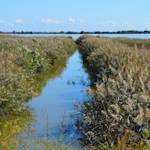The Water is Gone, The Land Is Dry, Desert Wetlands Drained
1990s • Iraq
“I used to swim all around here as a boy . . . now all the water is gone and the land is dry.” —Mahayal Ateia Msaver Although the Ba’athist government of Iraq "had been devising schemes to drain the marshlands for economic purposes since at least the 1950s, systematic drainage efforts began only after an abortive uprising against the government in 1991 and were motivated primarily by political rather than economic concerns. Starting in 1991, in part to facilitate entry into the area by the armed forces, authorities built a series of dams, dikes, and canals aimed at preventing the waters of the Tigris and the Euphrates from flowing into the marshes. The result, less than a decade later, was the destruction of the Middle East’s largest wetland ecosystem."
Tarquin Hall, "Iraq’s Systematic Drainage of Wetlands Drives Out Marsh Arabs : Environment: Reputed site of the Garden of Eden is desolate now, its reeds, pelicans, wild boar and water buffalo gone. One resident compared the devastation to that wrought by Genghis Khan. Government calls it civilization," Los Angeles Times, 19 October 1995. "The Iraqi Government Assault on the Marsh Arabs: A Human Rights Watch Briefing Paper," Human Rights Watch, January 2003.
Image: Hassan Janali, U.S. Army Corps of Engineers, Public domain, via Wikimedia Commons


Learn about Maya Lin’s fifth and final memorial: a multi-platform science based artwork that presents an ecological history of our world - past, present, and future.

Discover ecological histories and stories of former abundance, loss, and recovery on the map of memory.

Learn how we can reduce our emissions and protect and restore species and habitats – around the world.

See how art can help us rethink the problems we face, and give us hope that each one of us can make a difference.

Help make a global memorial something personal and close to home. Share your stories of the natural world.


